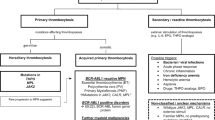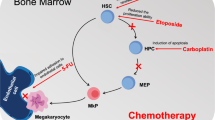Summary
Nearly all patients with cancer manifest laboratory evidence of hypercoagulability and some develop clinical thromboembolic disease (TED). Routine laboratory studies of blood coagulation have been performed in several large, prospective trials of the use of anticoagulant drugs in cancer treatment. The results of these studies, as well as data from several smaller studies of more sensitive tests of hypercoagulability [e.g. fibrinopeptide A (FPA); thrombin-antithrombin (TAT) complexes; prothrombin fragment F1+2)], indicate that the levels of some clotting proteins parallel disease activity. However, no studies of sound methodologic design have yet been performed to indicate that any of these tests of blood coagulation can serve as adequate predictors of TED in patients with cancer.
In addition to the important role played by tumor-related procoagulants, several other mechanisms may be involved in the pathogenesis of thromboembolic events in patients with cancer, including stasis and endothelial damage. Considerable variability in the relative importance of these mechanisms in the pathogenesis of TED may exist among patients with different types of cancer.
The risk for TED associated with surgical procedures in cancer patients is substantial and prophylactic antithrombotic therapy should be considered for most of these patients. Chemotherapy and hormonal therapy of cancer probably increases the likelihood of TED, particularly in those subjects with indwelling venous catheters. This risk has been particularly well-studied in patients with breast cancer treated with tamoxifen plus cytotoxic drugs. The pathogenic mechanisms may be complex but vascular injury is likely as a proximate cause of venous access catheter thrombosis and can be prevented with low dose coumadin therapy. The utility of low dose coumadin anticoagulation in reducing the risk for TED during breast cancer treatment is unknown but is currently being tested in a large, multiinstitutional study. Since chronic coumadin anticoagulation of cancer patients, and single pulse dose heparin prior to intravenous chemotherapy, both prevent thrombin generation, these agents may be of use in reducing the risk of chemotherapy-associated thrombosis. Prophylactic anticoagulation should be considered for high risk patients.
Similar content being viewed by others
References
TrousseauA: Phlegmasia alba dolens. In: Clinique Medicale de l'Hotel-Dieu de Paris. JB Balliere et Fils, Paris, vol 3, pp 654–712, 1865
RicklesFR, EdwardsRL: Leukocytes and tumor cells in thrombosis. In: ColmanRW, HirshJ, MarderVJ, SalzmanEW (eds) Hemostasis and thrombosis, 3rd Edition. J.B. Lippincott Co, Philadelphia, 1992, in press
RicklesFR, HancockWW, EdwardsRL, ZacharskiLR: Antimetastatic agents. I. Role of cellular procoagulants in the pathogenesis of fibrin deposition in cancer and the use of anticoagulants and/or antiplatelet drugs in cancer treatment. Sem Thromb Hem 14: 88–94, 1988
SunNC, McAfeeWM, HumGH, WeinerJM: Hemostatic abnormalities in malignancy, a prospective study in one hundred eight patients. Part I. Coagulation studies. Am J Clin Pathol 71: 10–16, 1979
EdwardsRL, RicklesFR, MoritzTE, HendersonWG, ZacharskiLR, FormanWB, CornellCJ, ForcierRJ, O'DonnellJF, HeadleyE, KimSH, O'DellR, TornyosK, KwaanHC: Abnormalities of blood coagulation tests in patients with cancer. Am J Clin Pathol 88: 596–602, 1987
CarlssonS: Fibrinogen degradation products in serum from patients with cancer. Acta Chir Scand 139: 499–502, 1973
OkajimaK, OkabeH, InoueM, TakasukiK: Characterization of the fibrinolytic state by measuring stable crosslinked fibrin degradation products in disseminated intravascular coagulation associated with acute promyelocytic leukemia. Acta Haematologica 81: 15–18, 1989
RicklesFR, EdwardsRL: Activation of blood coagulation in cancer: Trousseau's syndrome revisited. Blood 62: 14–31, 1983
WajimaT, MukhopadhyayP: Serial coagulation profiles in patients with small cell carcinoma of the lung. Thromb Haemostas Suppl 62: 136, 1989 (Abstract)
ZacharskiLR, MoritzTE, BaczekLA, RicklesFR EdwardsRL, FormanWB, ForcierRJ, CornellCJ, HaakensonCM, BallardHS, CrumED, JohnsonGJ, LevineJ, HongWK, O'DonnellJF, SchilskyRL, RingenbergQS, RobertF, SpauldingMB, TornyosK, WilliamsC, ZuckerS, FaulknerCS, EatonWL, HoppelCL: Effect of Mopidamol on survival in carcinoma of the lung and colon: final report of Veterans Administration Cooperative Study No. 188. J Nat Ca Instit 80: 90–97, 1988
Al-MondhiryH, LawlorBA, SadulaD: Fibrinogen survival and fibrinolysis in acute leukemia. Cancer 35: 432–435, 1975
LymanGH, BettigoleRE, RobsonE, AmbrusJL, UrbanH: Fibrinogen kinetics in patients with neoplastic disease. Cancer 41: 1113–1122, 1978
YodaY, AbeT: Fibrinopeptide A (FPA) level and fibrinogen kinetics in patients with malignant disease. Thromb Haemostas 46: 706–709, 1981
MombelliG, RouxA, HaeberliA, StraubPW: Comparison of125I-fibrinogen kinetics and fibrinopeptide A in patients with disseminated neoplasia. Blood 60: 381–388, 1982
PeuscherFW, CletonFJ, ArmstrongL, Stoepman-van DalenEA, vanMourikJA, vanAkenWG: Significance of plasma fibrinopeptide A (FPA) in patients with malignancy. J Lab Clin Med 96: 5–14, 1980
MyersTJ, RicklesFR, BarbC, CronlundM: Activation of blood coagulation in acute leukemia — fibrinopeptide A (FPA) generation as an indicator of disease activity. Blood 57: 518–525, 1981
RicklesFR, EdwardsRL, BarbC, CronlundM: Abnormalities of blood coagulation in patients with cancer: Fibrinopeptide A generation and tumor growth. Cancer 51: 301–307, 1983
BauerKA, RosenbergRD: Thrombin generation in acute promyelocytic leukemia. Blood 64: 791–796, 1984
NandS, FisherSG, SalgiaR, FisherRI: Hemostatic abnormalities in untreated cancer: incidence and correlation with thrombotic and hemorrhagic complications. J Clin Oncol 12: 1998–2003, 1987
AugerMJ, GallowayMJ, LeinsterSJ, McVerryBA, MackieMJ: Elevated fibrinopeptide A levels in patients with clinically localized breast carcinoma. Haemostasis 17: 336–339, 1987
LindahlAK, SandsetPM, AbildgaardU: Indices of hypercoagulation in cancer as compared with those in acute inflammation and acute infarction. Haemostasis 20: 253–262, 1990
GadducciA, BaicchiU, delBravoB: The assessment of the hemostasis system in patients with ovarian and cervical carcinoma. The Cancer J 4: 183–187, 1991
UchiyamaT, MatsumotoM, KobayashiN: Studies of the pathogenesis of coagulopathy in patients with arterial thromboembolism and malignancy. Thromb Res 59: 955–965, 1990
AbshireTC, GoldSH, OdomLF, CarsonSD, HathawayWE: The coagulopathy of childhood leukemia. Thrombin activation or primary fibrinolysis? Cancer 66: 716–721, 1990
BickRL: Disseminated intravascular coagulation and related syndromes: a clinical review. Sem Thromb Hem 14: 65–81, 1988
RubinRN, KiesMS, PoschJJ: Measurements of antithrombin III in solid tumor patients with and without hepatic metastases. Thromb Res 18: 353–360, 1980
HoneggerH, AndersonN, HewittLA, TullisJL: Antithrombin III profiles in malignancy, relationship to primary tumors and metastatic sites. Thromb Haem 46: 500–503, 1981
RodeghieroF, MannucciPM, ViganoS, BarbuiT, GugliottaL, CortellaroM, DiniE: Liver dysfunction rather than intravascular coagulations as the main cause of low protein C and antithrombin III in acute leukemia. Blood 63: 969–969, 1984
TroyK, EssexD, RandJ, LemaM, CuttnerJ: Protein C and S levels in acute leukemia. Am J Hematol 37: 159–162, 1991
SweeneyJD, KillionKM, PruetCF, SpauldingMB: von Willebrand factor in head and neck cancer. Cancer 66: 2387–2389, 1990
Falanga A, Levine M, Edwards RL, Moritz TE, Zacharski LR, Rickles FR: Clotting studies in cancer patients. Report from the Subcommittee on Haemostasis and Malignancy of the Scientific and Standardization Committee, International Society of Thrombosis and Haemostasis. In preparation, 1992
EdwardsRL, MorganDL, RicklesFR: Animal tumor procoagulants: Resistry of the Subcommittee on Haemostasis and Malignancy of the Scientific and Standardization Committee, International Society on Thrombosis and Haemostasis. Thromb Haem 63: 133–138, 1990; Edwards RL, Silver J, Rickles FR: Human tumor procoagulants. Registry of the Subcommittee on Haemostasis and Malignancy of the Scientific and Standardization Subcommittee, International Society on Thrombosis and Haemostasis. Thromb Haem, Submitted for Publication
EdwardsRL, RicklesFR: The role of leukocytes in the activation of blood coagulation. Sem Hematol 29: 202–212, 1992
TallmanM and KwaanHC: Reassessing the hemostatic disorder associated with acute promyelocytic leukemia. Blood 79: 543–553, 1992
AndohK, KkubotaT, TakadaM, TanakaH, KobayashiN, MaekawaT: Tissue factor activity in leukemic cells. Special reference to disseminated intravascular coagulation. Cancer 59: 748–754, 1987
KubotaT, AndohK, SadakataH, TanakaH, KobayashiN: Tissue factor released from leukemic cells. Thromb Haem 65: 59–63, 1991
FalangaA, AlessioMG, DonatiMB, BarbuiT: A new procoagulant in acute leukemia. Blood 71: 870–875, 1988
DonatiMB, FalangaA, ConsonniR, AlessioG, BassanR, BuelliM, BorinL, CataniL, PoglianiE, GugliottaL, MaseraG, BarbuiT: Cancer procoagulant in acute non lymphoid leukemia: relationship of enzyme detection to disease activity. Thromb Haem 64: 11–16, 1990
CozzolinoF, TorciaM, MilianiA, CarossinoAM, GiordaniR, CinottiS, FilimbertiE, SaccardiR, BernabeiP, GuidiG, DiGuglielmoR, PistoiaV, FerrariniM, NawrothPP, SternD: Potential role of interleukin-1 as the trigger for diffuse intravascular coagulation in acute nonlymphoblastic leukemia. Am J Med 84: 240–250, 1988
WijermansPW, RebelVI, OssenkoppeleGJ, HuijgensPC, LangenhujsenMMAC: Combined procoagulant activity and proteolytic activity of acute promyelocytic leukemic cells: Reversal of the bleeding disorder by cell differentiation. Blood 73: 800–805, 1989
TakahashiH, TatewakiW, WadaK, HananoM, ShibataA: Thrombin vs. plasmin generation in disseminated intravascular coagulation associated with various underlying disorders. Am J Hematol 33: 90–95, 1990
BennettB, BoothNA, CrollA, DawsonAA: The bleeding disorder in acute promyelocytic leukemia: fibrinolysis due to u-PA rather than defibrination. Br J Haematol 71: 511–515, 1989
SchwartzBS, WilliamsEC, ConlanMG, MosherDF: Epsilon amino caproic acid in the treatment of patients with acute promyelocytic leukemia and acquired alpha-2-plasmin inhibitor deficiency. Ann Int Med 105: 873–877, 1986
SalzmanEW, HirshJ: Prevention of venous thromboembolism In: ColmanRW, HirshJ, MarderVJ, SalzmanEW (eds) Hemostasis and Thrombosis: Basic principles and clinical practice. Lippincott, Philadelphia, pp 1252–1265, 1987
FraschiniG, JadejaJ, LawsonM, HolmesFA, CarrascoHC, WallaceS: Local infusion of urokinase for the lysis of thrombosis associated with permanent central venous catheters in cancer patients. J Clin Oncol 5: 672–678, 1987
ClagettGP, ReischJS: Prevention of venous thromboembolism in general surgical patients. Ann Surg 208: 227–240, 1988
Clarke-PearsonDL, ColemanRE, SynanIS, HinshawW, CreasmanWT: Venous thromboembolism prophylaxis in gynecologic oncology: a prospective controlled trial of low dose heparin. Am J Obstet Gynecol 145: 606–613, 1983
Clarke-PearsonDL, SynanIS, HinshawWM, ColemanE, CreasmanWT: Prevention of postoperative venous thromboembolism by external pneumatic calf compression in patients with gynecologic malignancy. Obstet Gynecol 63: 92–98, 1984
Clarke-PearsonDL, CreasmanWT, ColemanRE, SynanIS, HinshawWM: Perioperative external pneumatic calf compression as thromboembolism prophylaxis in gynecologic oncology: report of a randomized controlled trial. Gynecol Oncol 18: 222–232, 1984
Clarke-PearsonDL, DelongE, SynanIS, HinshawWM: A controlled trial of two low-dose heparin regimens for the prevention of postoperative deep vein thrombosis. Obstet Gynecol 75: 684–689, 1990
CoeNP, CollinsREC, KleinLA, BettmannMA, SkillmanJJ, ShapiroRM, SalzmanEW: Prevention of deep vein thrombosis in urological patients: a controlled randomized trial of low dose heparin and external pneumatic compression boots. Surgery 83: 230–234, 1978
KutnowskiM, VandendrisM, SteinbergerR, KraytmanM: Prevention of postoperative deep vein thrombosis by low dose heparin in urologic surgery. Urolog Res 5: 123–125, 1977
TurpieAGG, GallusAS, BeattieWS, HirshJ: Prevention of venous thrombosis in patients with intracranial disease by intermittent pneumatic compression of the calf. Neurology 27: 435–438, 1977
CerratoD, ArianoC, FiacchinoF: Deep vein thrombosis and low dose heparin prophylaxis in neurosurgical patients. J Neurosurg 49: 378–381, 1978
SkillmanJJ, CollinsREC, CoeNP, GoldsteinBS, ShapiroRM, ZervesNT, BettmannMA, SalzmanEW: Prevention of deep vein thrombosis in neurosurgical patients: a controlled, randomized trial of external pneumatic compression boots. Surgery 83: 354–358, 1978
TurpieAGG, DoyleDJ, SaerensE, deBoerAC, TalbotC, McNameeJ, HirshJ: An evaluation of suloctidil in the prevention of deep vein thrombosis in neurosurgical patients. Thromb Res 39: 173–181, 1985
TurpieAGG, DelmoreT, HirshJ, HullR, GentonE, HiscoeC, GentM: Prevention of venous thrombosis by intermittent sequential calf compression in patients with intracranial disease. Thromb Res 15: 611–616, 1979
WeissRB, TormeyDC, HollandJF, WeinbergVE: Venous thrombosis during multimodal treatment of primary breast carcinoma. Cancer Treat Rep 65: 677–679, 1981
LevineM, GentM, HirshJ, ArnoldA, GoodyearMD, HryniukW, DePauwS: The thrombogenic effect of anticancer drug therapy in women with Stage II breast cancer. N Engl J Med 318: 404–407, 1988
PritchardKI, PaterJ, PatersonAHJ, FineS: Thromboembolic complications related to chemotherapy. Proc Amer Soc Clin Oncol 8: 25, 1989 (Abstract)
WallJG, WeissRB, NortonL, PerloffM, RiceMA, KorzunAH, WoodWC: Arterial thrombosis associated with adjuvant chemotherapy for breast carcinoma: a Cancer and Leukemia Group B study. Amer J Med 87: 501–504, 1989
SaphnerT, TormeyDC, GrayR: Venous and arterial thrombosis in patients who received adjuvant therapy for breast cancer. J Clin Oncol 9: 286–294, 1991
FisherB, ConstantinoJ, RedmondC, PoissonR, BowmanD, CoutureJ: A randomized clinical trial evaluating Tamoxifen in the treatment of patients with node-negative breast cancer who have estrogen receptor positive tumors. N Engl J Med 320: 479–484, 1989
GoodnoughLT, SaitoH, ManniA, JonesPK, PearsonOH: Increased incidence of thromboembolism in Stage IV breast cancer patients treated with five-drug chemotherapy regimen: a study of 159 patients. Cancer 54: 1264–1268, 1984
BernMM, LokichJJ, WallachSR, BotheA, BenottiPN, ArkinCF, GrecoFA, HubermanM, MooreC: Very low doses of warfarin can prevent thrombosis in central venous catheters. A randomized prospective trial. Ann Int Med 112: 423–428, 1990
EdwardsRL, KlausM, MatthewsE, McCullenC, BonaRD, RicklesFR: Heparin abolishes the chemotherapy-induced increases in plasma fibrinopeptide A levels. Am J Med 89: 25–28, 1990
Author information
Authors and Affiliations
Rights and permissions
About this article
Cite this article
Rickles, F.R., Levine, M. & Edwards, R.L. Hemostatic alterations in cancer patients. Cancer Metast Rev 11, 237–248 (1992). https://doi.org/10.1007/BF01307180
Issue Date:
DOI: https://doi.org/10.1007/BF01307180




